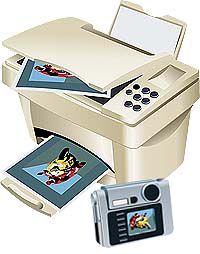Digital imaging in today’s world has become extremely popular. Many have replaced traditional cameras with digital ones, and others are scanning (converting) older prints and film into digital equivalents.
However, as digital technologies replace older technologies, quality control becomes extremely important. One measure of quality is PPI, or “pixels per square inch.” Unfortunately, PPI is often misunderstood.
To understand PPI, it is important to understand what a digital image actually is. To a computer, a digital image is simply a collection of tiny colored “dots” (interpreted as small squares) called pixels arranged in rectangular fashion. As a whole, the computer sees the image as information. It has no way of knowing what the subject of the image is of, or whether the image is in focus or not.
To a human being, these pixels collectively form an image that has some sort of meaning. We don’t see colored blocks, but rather a beautiful mountain vista or a moment during a birthday party.
It is critical to understand that a pixel by itself has no real-world or physical value. It is a piece of information, not a physical item. As a result, because a digital image is composed entirely of pixels, it also lacks tangible dimensions. This becomes a problem when we want to print such an image, because the printer won’t know what to do with the pixels in the image.
PPI gives a photo physical dimensions by simply allocating a specified number of pixels to a square inch. It does this by dividing the pixels into equal, square regions. When PPI is changed, the pixels in the image itself never change – only the pixel allocation per inch (pixel grouping size) changes.
For example, when we increase the PPI, we are actually decreasing the total print dimensions (tangible dimensions, measured in inches) of the image. Each square inch will contain more pixels, and the print dimensions of each pixel decreases in size to accommodate the extra pixels per inch. The image will print smaller, but with better quality than the other image.
In contrast, if we decrease the PPI, we increase the total print dimensions of the image. Each square inch will contain less pixels, and the print dimensions of each pixel increases in size. The image will print larger, but with less quality than the other image.
In another example, let’s say we have two digital images. These images are nearly identical. Both are of the same subject. Both are 4×6 inch images. However, one image is 150 PPI and the other is 300 PPI. The 300 PPI image will have a much larger file size (usually measured in kilobytes (KB) or megabytes (MB)) than the 150 PPI image. This is because the 300 PPI image has double the total pixels than the 150 PPI image.
If both images are printed on a common printer with the same printer settings, both will print out exactly the same size (4×6 inches). However, the 300 PPI image will print much clearer and crisper than the 150 PPI image.
Generally speaking, a 4×6 inch photo with low PPI will look grainy (or ‘pixelated’) when printed, whereas a 4×6 inch photo with a very high PPI will look cleaner and crisper. The more pixels you have in your image, the more flexible PPI control will be.
An important note should be made concerning PPI versus DPI. PPI (“pixels per square inch” and DPI (“dots per square inch”) are often used interchangeably. However, DPI doesn’t always refer to pixels. Keep that in mind when purchasing digital-imaging products or related accessories.
Most modern imaging devices (scanners, cameras, printers, etc) take a lot of the guesswork out of digital imaging and photography in an attempt to maximize quality, but having a basic understanding of what PPI actually is, and how it works gives you more control over your digital images.
In subsequent articles in this Digital Imaging series, PPI will be discussed in further detail and how it applies to scanners, printers and other digital imaging technologies.
Have comments or suggestions for a weekly Tech Tips article? Send an email to webmaster@sunad.com.
Digital Imaging, Part 1 – PPI

